Jump to:
Granular Physics
Experiment
Spaceballs
GrAINS
GrAINS II
GrAINS III
What is Granular Physics?
Have you ever wondered why when you shake a bucket of popcorn all the unpoped kernels seem to go to the bottom? Have you ever wondered why sand dunes look like waves? Have you ever wondered why an avalanche flowing downhill seems to "flow" much like a liquid? These are questions that a granular physisist asks. A great deal of effort, both in industry and academia, has focused on studying the interactions within and the overall behavior of granular systems.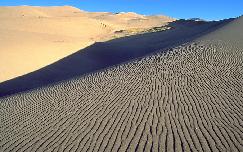 Of particular interest have been studies of "gases" of macroscopic objects such as ball bearings, dust, soot, etc. Theoretical models have predicted and some experiments have verified that a driven granular gas (such as a "gas" of ball bearings) tends to form clusters when the gas is undisturbed by external forces such as gravity. Clustering is the consequence of energy dissipation due to inelastic collisions between balls. The continued dissipation of energy leads to inelastic collapse, where two or more balls lose all relative motion. The behavior of such clusters appears to be dependent on driving parameters, particle number densities and the coefficients of restitution of the balls. The motions of individual balls have been analyzed in two-dimensional granular systems. Analysis have not yet been performed on three dimensional systems. The only low gravity three- dimensional experiment performed to date was on a set of relatively dense granular gases.
Of particular interest have been studies of "gases" of macroscopic objects such as ball bearings, dust, soot, etc. Theoretical models have predicted and some experiments have verified that a driven granular gas (such as a "gas" of ball bearings) tends to form clusters when the gas is undisturbed by external forces such as gravity. Clustering is the consequence of energy dissipation due to inelastic collisions between balls. The continued dissipation of energy leads to inelastic collapse, where two or more balls lose all relative motion. The behavior of such clusters appears to be dependent on driving parameters, particle number densities and the coefficients of restitution of the balls. The motions of individual balls have been analyzed in two-dimensional granular systems. Analysis have not yet been performed on three dimensional systems. The only low gravity three- dimensional experiment performed to date was on a set of relatively dense granular gases. The question of collapse has particular importance for a description of the dynamics of interstellar dust clouds, planet formation and planetary ring systems. Measurements of asteroid densities have shown that objects less than about 1 km3 in volume have densities on the order of 1-1.5 g/cm3. At these densities, an object 100 meters in radius has an escape velocity of ~10 cm/s. With such small escape speeds these objects are not able to gravitationally accumulate mass and thus are not able to accrete dust and grow in size. Inelastic collapse, if it were shown to occur in dilute granular systems, would provide a means for the formation of these moderately sized objects.
The question of collapse has particular importance for a description of the dynamics of interstellar dust clouds, planet formation and planetary ring systems. Measurements of asteroid densities have shown that objects less than about 1 km3 in volume have densities on the order of 1-1.5 g/cm3. At these densities, an object 100 meters in radius has an escape velocity of ~10 cm/s. With such small escape speeds these objects are not able to gravitationally accumulate mass and thus are not able to accrete dust and grow in size. Inelastic collapse, if it were shown to occur in dilute granular systems, would provide a means for the formation of these moderately sized objects.This research project employs an apparatus built by the students of the Granular Physics Research Group at the University of Tulsa. Preliminary testing of the apparatus has been undertaken on four flights aboard the NASA KC-135 low gravity airplane. We have made arrangements for our apparatus to fly aboard a NASA Space Shuttle.
In this research project we look for the occurrence of clustering and inelastic collapse within driven granular gases that are in a low gravity environment. We intend to:
1. Study how the driving parameters, particle number densities and coefficients of restitution influence the phenomena of clustering and collapse.
2. Analyze impact data to obtain values of granular pressure within our test chambers.
3. Assemble velocity distributions for the granular gas phases to obtain values of granular temperature.
4. Study how granular pressure and temperature scale with driving parameters.
5. Investigate the possible existence of an equation of state for granular gases.
Our Experiment
 The TU Granular Physics Group has built an apparatus to study a driven granular gaseous system in three dimensions. The goals of the experiment are
The TU Granular Physics Group has built an apparatus to study a driven granular gaseous system in three dimensions. The goals of the experiment are
- Study how the driving parameters, particle number densities and coefficients of restitution influence the phenomena of clustering and collapse.
- Analyze impact data to obtain values of granular pressure within our test chambers.
- Assemble velocity distributions for the granular gas phases to obtain values of granular temperature.
- Study how granular pressure and temperature scale with driving parameters.
Spaceballs
 When the experiment first got started it was called SpaceBalls (yes like the movie). The first phase of the experiment was to model the inelastic collapse on a computer. Sean Davis and Whitney Marshal developed code in IDL which simulated the inelastic collisions in two dimensions. These simulations allowed us to guess the values of many parameters, such as particle size and number densities.
When the experiment first got started it was called SpaceBalls (yes like the movie). The first phase of the experiment was to model the inelastic collapse on a computer. Sean Davis and Whitney Marshal developed code in IDL which simulated the inelastic collisions in two dimensions. These simulations allowed us to guess the values of many parameters, such as particle size and number densities. Watch a video of a simulation.
GrAINS
For the 2002 test flight program the project was named GrAINS, an acronym for Granular Agglomeration in Non-gravitating Systems. The goal of the flight was to test to apparatus, and collect some preliminary pressure and video data.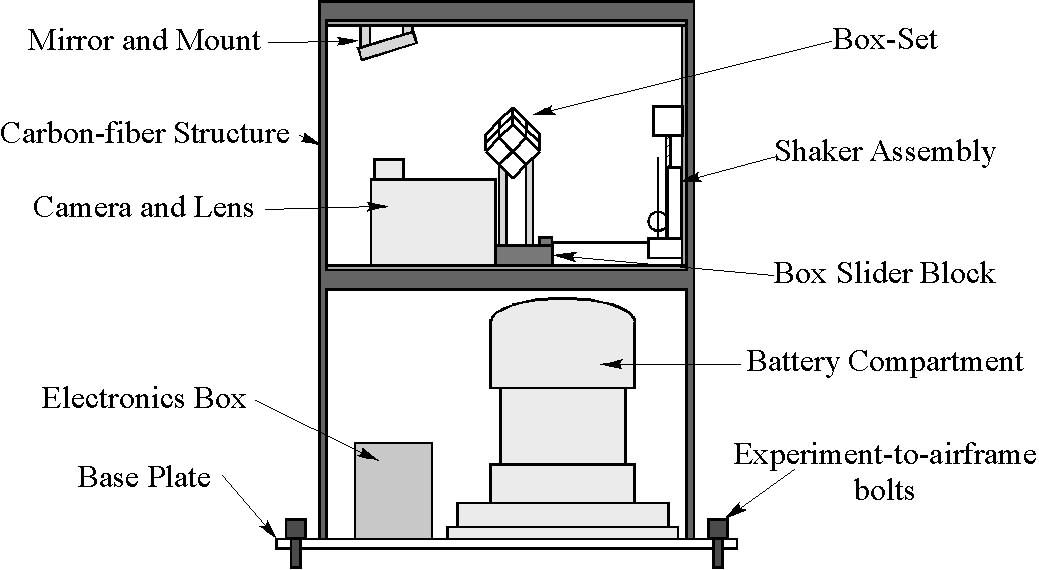 The GrAINS team built the apparatus from scratch. The experiment will consist of a
box set with pressure sensors, a mechanical
shaker system, camera's and the
optical system, a control system, a
battery pack, and
support structure for entire system. The pictures show the layout of all the systems.
The GrAINS team built the apparatus from scratch. The experiment will consist of a
box set with pressure sensors, a mechanical
shaker system, camera's and the
optical system, a control system, a
battery pack, and
support structure for entire system. The pictures show the layout of all the systems.The GrAINS experiment had a successful flight aboard the zero gravity airplane. However many potential problems were discovered, such as restricted view of the box, bad lighting. In addition very little valuable data was taken because the random movement of the plane.
GrAINS II
For the 2003 test flight the program was called GrAINS II, because we could not use same name twice. The main goal of this flight program was to get some sample data, and the secondary goal was to further test the apparatus.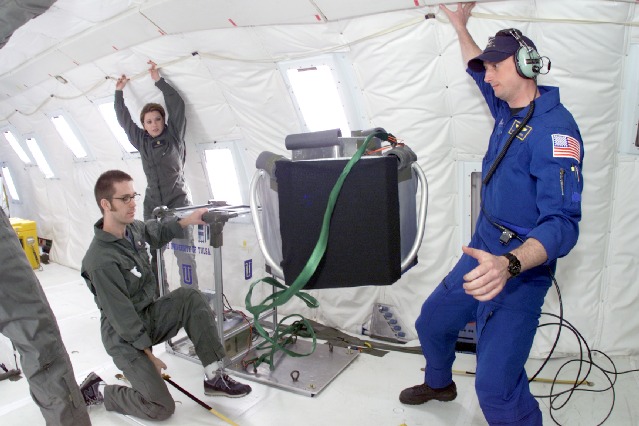 The apparatus was changed so that we could make it float freely, thereby eliminating the plane's movement. The battery pack was taken out, and we used the plane's power supply to power the experiment. The support structure was replaced with one half the size and with much bigger openings so that the team members could work on the experiment more easily. The picture shows the GrAINS II apparatus in flight.
The apparatus was changed so that we could make it float freely, thereby eliminating the plane's movement. The battery pack was taken out, and we used the plane's power supply to power the experiment. The support structure was replaced with one half the size and with much bigger openings so that the team members could work on the experiment more easily. The picture shows the GrAINS II apparatus in flight.The GrAINS II experiment had two successful flights aboard the zero gravity airplane. The experiment recorded video data from two cameras for more than 20 parabolas (zero gravity sessions). While two cameras did record, the third never focused. In addition the tapes ran out before the last parabola. It was determined that the experiment needed more control over the camera
functions (turning them on and off, starting and stopping recording, focus), also a better method for logging the pressure is needed.
GrAINS III
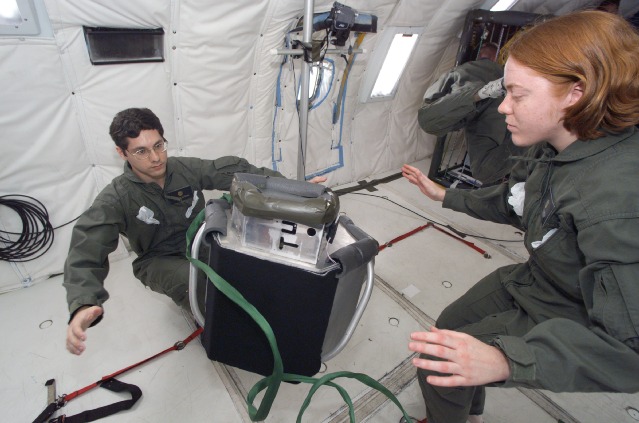
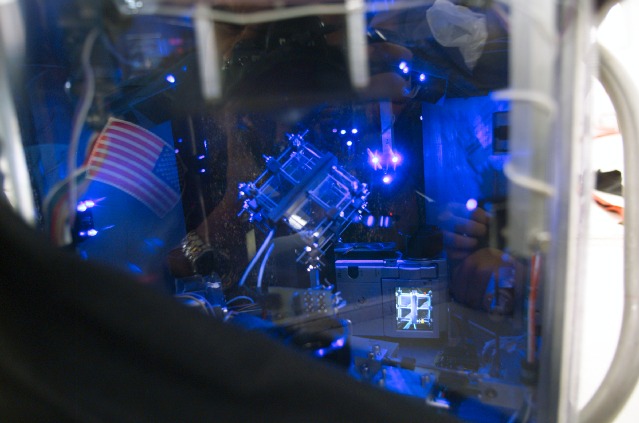
GrAINS III flew aboard NASA's KC-135 "Weightless Wonder" in July 2004. As in the past, the experiment was a free float design. The experiment incorporated a new microcontroller with advanced data-logging capabilities. Unfortunately, there were some technical issues and validity of data is questionable. Data Analysis will continue nevertheless.
